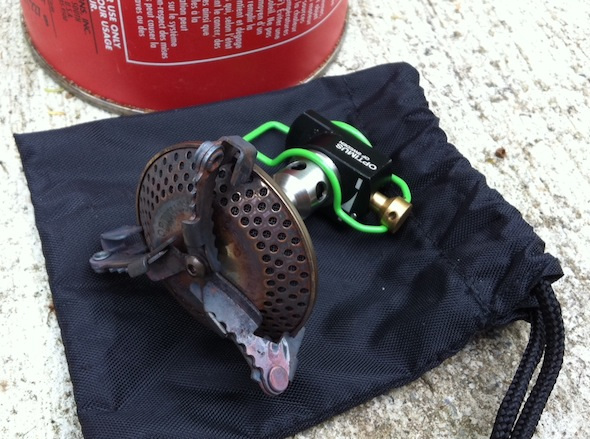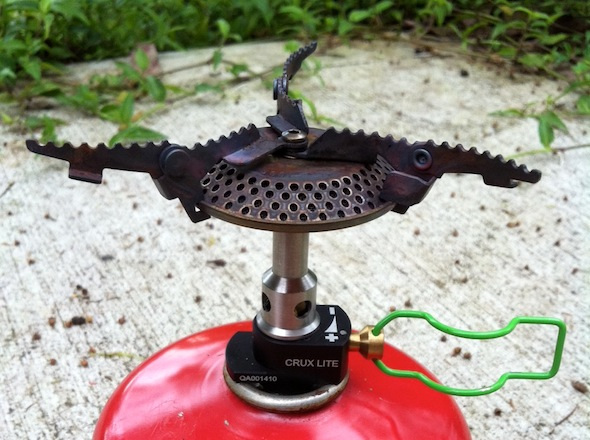UPDATE: I originally wrote this review in 2012, just after purchasing the Optimus Crux Lite stove. For the past five years it served me very well. I finally replaced it recently after my original concern — that the three moving arms that hold the pot would break — finally occurred.
I would estimate that it took several years of use before there started to be problems with these arms. Initially it was just some stiffness, making them hard to open and close. This progressively got worse. Finally, on a recent trip in the USA, the fine desert sand got too much for them and one of the arms jammed tight. When I pushed really hard to try to close it, the arm bent.
My advice to anyone buying this stove is to work hard to keep the joints clean. Perhaps some WD40 or similar between trips to lubricate the joints and help prevent rust would also assist. Still, even with this obvious design flaw eventually causing problems, I did get five years of good service out of this stove, which is still quite impressive.
Original review:
When I first started bushwalking I was pretty old fashioned with my gear and techniques. I basically used my old Army stuff for everything from clothing and footwear to packs and shelter. The only stove I’d ever used in that role was an old fashioned hexamine stove. For those who’ve never used one, they are basically a small metal stove that runs on little blocks of solid fuel. They are cheep, relatively light, and pretty well unbreakable, which is probably why the military love them.
For most walks I stuck to simple food that didn’t require cooking. If it was a longer trip I’d do uncooked lunches then if I wanted a warm meal, I’d cook it on the fire. I didn’t really feel the need for a stove, and it fitted with my dislike of fancy technology in the bush.

Then came some wet, miserable walks, where fire lighting was very hard and a hot meal a real luxury, and I started to see why a stove would be useful.
My first gas stove was the Kovea X1 Solo. It seemed pretty light at the time, was robust, and had a self ignition. For about four or five years it served me well. As I became a more active canyoner, the ability to have a hot lunch in a cold canyon (without lighting a fire, which can be very damaging to these sensitive environments) made it an even more integral part of my kit, even on day trips.
Unfortunately, years of heavy use has taken its toll. The self ignition died first, after a couple years. The stove still works, but has bits pealing off and is clearly less effective in poorer conditions than it once was. Much of this is my own fault, with the stove regularly getting wet and being mistreated, so I don’t blame the manufacturer at all. The core elements — the burner, pot holding arms etc — all continue to work.

I decided that ahead of a big week-long canyoning trip in a remote area I should invest in a new stove, not wanting this old one to give up the ghost completely on me.
I figured you never really know what will work best until you try something, so didn’t shop around too much, and instead looked for something that would work for me. Basically, all I wanted was something very light, with limited moving parts that could break, and with versatile pot holding arms that can be used with odd shaped cookware.
The last point is based on the fact that I still use my old Australian Army steel kidney cup to cook. The reason I’ve kept using this, even in spite of its weight, is that they are absolutely unbreakable, have a folding handle, are easy to clean, and best of all can be used on either a stove or the fire.

I also wanted to avoid one with a self-ignition given these invariably break, add extra weight, and every bushwalker carries matches anyway, just in case a fire needs to be lit in an emergency.
Most people I know seem to use the MSR Pocket Rocket, which seems a good stove, but its arms do not work well with my pot, and make the risk of food toppling off very high.
I ended up picking up the Optimus Crux Lite. Amazingly it was almost half the price of the MSR, a good 10 grams lighter, and seemed to have an even larger jet for when you decide to boil with a larger pot.
According to the manufacturer it is just 72 grams and can boil 1L of water in as little as 3 minutes. Given my old stove weighed in at 124g new, and was getting pretty sluggish, this seemed a huge improvement.

Field testing:
During the seven day walk, I cooked every lunch on the Optimus, along with all dinners and even cups of tea on one wet night. Some of the meals I cooked required extensive simmering — up to 15 minutes — so I expected the fuel use to be substantial. Amazingly I used not much more than half a 227g canister of gas by the end of the week. I was blown away by how reasonable this was, given the intense flame this stove emits when turned up on high.
The big issue I have had in the past when borrowing other people’s stoves is with simmering. It seems any stove can blast out the gas, but when you need a precise, low flame, many either cannot go low enough without extinguishing, or lack the fine control needed to get the heat just right. Once I got use to the Optimus I found this to be pretty good.
The only weaknesses that struck me were that when you first light the flame, you need to turn it up slightly or it can go out. Perhaps that is because I try to light it on a very low setting. Also, the wire handle for adjusting the fuel is a little fiddly when trying to be extremely precise. Again this issue diminished the more I got use to the stove. By the end of the trip neither issue was causing me problems.
Testing at home:
Reaching a rolling boil of 500ml of water in my steel kidney cup (time, and gas used)
– Optimus Crux Lite — 2:29 | burning 10g of fuel
– Kovea X1 Solo — 3:25 | burning 14g of fuel
Weight (on fancy electronic scales):
– Optimus Crux Lite — 73g (82g in storage stuff bag)
– Kovea X1 Solo — 124g (153g in plastic case)
Conclusion:
Overall I’m very happy with my purchase. It’s a small, light stove that seems to be very effective. It holds odd shaped cookware well, and is surprising stable for such a small stove. It performs well both when boiling water, or when cooking with a more gentle flame.
Long term my only concern is with the strength of the joints on the three arms. They feel sturdy, and have given me no troubles, but given they are the only moving parts I assume they are the weakest point. If that does occur, I’ll provide an update.
